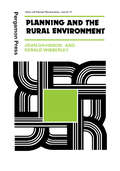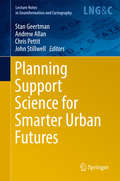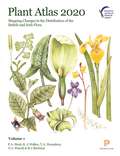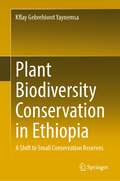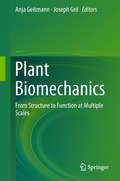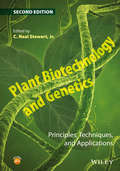- Table View
- List View
Planning and Installing Solar Thermal Systems: A Guide for Installers, Architects and Engineers (Planning and Installing)
by German Solar Energy Society (DGS)Solar thermal systems available today offer efficiency and reliability. They can be applied in different conditions to meet space- and water-heating requirements in the residential, commercial and industrial building sectors. The potential for this technology and the associated environmental benefits are significant. This fully updated edition of 2004's bestselling guide offers clear guidance on planning and installing a solar thermal system, crucial to the successful uptake of this technology. All major topics for successful project implementation are included. Beginning with resource assessment and an outline of core components, it details solar thermal system design, installation, operation and maintenance for single households, large systems, swimming pool heaters, solar air and solar cooling applications. Details on how to market solar thermal technologies, a review of relevant simulation tools and data on selected regional, national and international renewable energy programmes are also provided. In short, the book offers comprehensive guidance for professionals who wish to install solar thermal technology and is a highly valued resource for architects and engineers alike who are working on new projects, electricians, roofers and other installers, craftsmen undertaking vocational training and anyone with a specialized and practical interest in this field. Published with DGS
Planning and the Rural Environment: Urban and Regional Planning Series
by Joan Davidson Gerald WibberleyPlanning and the Rural Environment examines the environmental issues affecting countryside planning. Emphasis is placed on the look and feel of the open countryside, the function and appearance of the rural environment, rather than the problems of its people and the settlements in which they live. Also discussed is the conflict of interest generated between some of the major planning systems concerned with the development of rural activities and the protection of rural resources. Comprised of 13 chapters, this volume begins with an assessment of conflicting views of how a countryside of the future should develop and the degree of control and direction that should take place. The following chapters consider how the emerging range of environmental problems and opportunities in rural planning can best be illustrated. In particular, the dominance of agriculture as a rural activity is analyzed, together with forest and woodland management; leisure activity in the countryside; and conservation of resources and wildlife. The next section is devoted to uplands and the urban fringe, paying particular attention to some of the ways in which rural interests interact in two very different areas. Finally, the development of rural planning is reviewed and issues that are expected to shape the countryside of the future are considered. This book should be of interest to postgraduate students of rural planning and specialists in various fields of countryside planning.
Planning and Zoning New York City
by Todd BressiTwo unique events shaped the magnificent unnatural geography of New York City and created its sense of place: the Commissioners' Plan of 1811 and the zoning resolution of 1916. The first imprinted Manhattan with a two-dimensional plan, a rectangular grid defined by broad north-south avenues, multiple east-west cross streets, and by its standard units: blocks of two hundred feet by six hundred to eight hundred feet. The second determined the city's three-dimensional form by restricting uses by district, by limiting the maximum mass of a building allowed on a given site.This book addresses the fundamental challenge facing every American municipality: Can zoning - the basic tool of municipal land-use control - balance growth and equity? As New York plans for the future, the nation's foremost commentators on urban planning, architecture, land-use law, and design discuss the accomplishments of New York's zoning laws and explore alternative scenarios for guiding the city's future development.The chapters in this book were originally prepared for a symposium on the history and future of planning in New York City. The authors provide a skillful blend of urban history, architectural review, economic analysis, and social commentary. Contributors include such experts as Jonathan Barnett, Sigurd Grava, Frances Halsband, Jerold Kayden, Brian Kintish, Eric Kober, Michael Kwartler, Larry Littlefield, Norman Marcus, R. Susan Motley, Richard A. Plunz, Peter D. Salins, Richard L. Schaffer, John Shapiro, Robert A. M. Stern, Roy Strickland, Marilyn Taylor, Robert F. Wagner, Jr., and Carol Willis. This book is essential reading for planners, architects, historians, developers, and municipal officials concerned with guiding the future of America's cities. Its lessons are vital for every city in America.
Planning and Zoning New York City
by Todd BressiTwo unique events shaped the magnificent unnatural geography of New York City and created its sense of place: the Commissioners' Plan of 1811 and the zoning resolution of 1916. The first imprinted Manhattan with a two-dimensional plan, a rectangular grid defined by broad north-south avenues, multiple east-west cross streets, and by its standard units: blocks of two hundred feet by six hundred to eight hundred feet. The second determined the city's three-dimensional form by restricting uses by district, by limiting the maximum mass of a building allowed on a given site.This book addresses the fundamental challenge facing every American municipality: Can zoning - the basic tool of municipal land-use control - balance growth and equity? As New York plans for the future, the nation's foremost commentators on urban planning, architecture, land-use law, and design discuss the accomplishments of New York's zoning laws and explore alternative scenarios for guiding the city's future development.The chapters in this book were originally prepared for a symposium on the history and future of planning in New York City. The authors provide a skillful blend of urban history, architectural review, economic analysis, and social commentary. Contributors include such experts as Jonathan Barnett, Sigurd Grava, Frances Halsband, Jerold Kayden, Brian Kintish, Eric Kober, Michael Kwartler, Larry Littlefield, Norman Marcus, R. Susan Motley, Richard A. Plunz, Peter D. Salins, Richard L. Schaffer, John Shapiro, Robert A. M. Stern, Roy Strickland, Marilyn Taylor, Robert F. Wagner, Jr., and Carol Willis. This book is essential reading for planners, architects, historians, developers, and municipal officials concerned with guiding the future of America's cities. Its lessons are vital for every city in America.
Planning for Ecosystem Services in Cities (SpringerBriefs in Environmental Science)
by Davide Geneletti Chiara Cortinovis Linda Zardo Blal Adem EsmailThis open access book presents current knowledge about ecosystem services (ES) in urban planning, and discusses various urban ES topics such as spatial distribution of urban ecosystems, population distribution, and physical infrastructure properties. The book addresses all these issues by: i) investigating to what extent ecosystem services are currently included in urban plans, and discussing what is still needed to improve planning practice; ii) illustrating how to develop ecosystem services indicators and information that can be used by urban planners to enhance plan design; iii) demonstrating the application of ES assessments to support urban planning processes through case studies; and iv) reflecting on criteria for addressing equity in urban planning through ecosystem service assessments, by exploring issues associated with the supply of, the access to and demand for ES by citizens. Through fully worked out case studies, from policy questions, to baseline analysis and indicators, and from option comparison to proposed solutions, the book offers readers detailed and accessible coverage of outstanding issues and proposed solutions to better integrate ES in city planning. The overall purpose of the book is to provide a compact reference that can be used by researchers as a key resource offering an updated perspective and overview on the field, as well as by practitioners and planners/decision makers as a source of inspiration for their activity. Additionally, the book will be a suitable resource for both undergraduate and post-graduate courses in planning and geography.
Planning for Public Transport Accessibility: An International Sourcebook
by Carey Curtis Jan ScheurerBringing together a comparative analysis of the accessibility by public transport of 23 cities spanning four continents, this book provides a "hands-on" introduction to the evolution, rationale and effectiveness of a new generation of accessibility planning tools that have emerged since the mid-2000s. The Spatial Network Analysis for Multimodal Urban Transport Systems (SNAMUTS) tool is used as a practical example to demonstrate how city planners can find answers as they seek to improve public transport accessibility. Uniquely among the new generation of accessibility tools, SNAMUTS has been designed for multi-city comparisons. A range of indicators are employed in each city including: the effectiveness of the public transport network; the relationship between the transport network and land use activity; who gets access within the city; and how resilient the city will be. The cities selected enable a comparison between cities by old world–new world; public transport modes; governance approach; urban development constraints. The book is arranged along six themes that address the different planning challenges cities confront. Richly illustrated with maps and diagrams, this volume acts as a comprehensive sourcebook of accessibility indicators and a snapshot of current policy making around the world in the realm of strategic planning for land use transport integration and the growth of public transport. It provides a deeper understanding of the complexity, opportunities and challenges of twenty-first-century accessibility planning.
Planning for Public Transport Accessibility: An International Sourcebook
by Carey Curtis Jan ScheurerBringing together a comparative analysis of the accessibility by public transport of 23 cities spanning four continents, this book provides a "hands-on" introduction to the evolution, rationale and effectiveness of a new generation of accessibility planning tools that have emerged since the mid-2000s. The Spatial Network Analysis for Multimodal Urban Transport Systems (SNAMUTS) tool is used as a practical example to demonstrate how city planners can find answers as they seek to improve public transport accessibility. Uniquely among the new generation of accessibility tools, SNAMUTS has been designed for multi-city comparisons. A range of indicators are employed in each city including: the effectiveness of the public transport network; the relationship between the transport network and land use activity; who gets access within the city; and how resilient the city will be. The cities selected enable a comparison between cities by old world–new world; public transport modes; governance approach; urban development constraints. The book is arranged along six themes that address the different planning challenges cities confront. Richly illustrated with maps and diagrams, this volume acts as a comprehensive sourcebook of accessibility indicators and a snapshot of current policy making around the world in the realm of strategic planning for land use transport integration and the growth of public transport. It provides a deeper understanding of the complexity, opportunities and challenges of twenty-first-century accessibility planning.
Planning for Resilience: New Paths for Managing Uncertainty (SpringerBriefs in Geography)
by Elena PedeGiven the increasing uncertainty due to catastrophic climate events, terrorist attacks, and economic crises, this book addresses planning for resilience by focusing on sharing knowledge among policy-makers, urban planners, emergency teams and citizens. Chapters look at the nature of contemporary risks, the widespread of resilience thinking and the gap between the theoretical conception and the practices. The book explores how resilience implies a change in planning practices, highlighting the need for flexibility in terms of procedures, and for dynamism in the knowledge systems and learning processes that are the main tools for interaction among different actors and scales. Given its breadth of coverage, the book offers a valuable resource for both academic readers (spatial planners, geographers, social scientists) and practitioners (policymakers, citizens’ associations).
Planning for the Planet: Environmental Expertise and the International Union for Conservation of Nature and Natural Resources, 1960–1980 (Environment in History: International Perspectives #16)
by Simone SchleperDuring the 1960s and 1970s, rapidly growing environmental awareness and concern created unprecedented demand for ecological expertise and novel challenges for ecological advocacy groups such as the International Union for Conservation of Nature and Natural Resources (IUCN). This book reveals how, despite their vast scientific knowledge and their attempts to incorporate socially relevant themes, IUCN experts inevitably struggled to make global schemes for nature conservation a central concern for UNESCO, UNEP and other intergovernmental organizations.
Planning Support Science for Smarter Urban Futures (Lecture Notes in Geoinformation and Cartography)
by Stan Geertman Andrew Allan Chris Pettit John StillwellThis book offers a selection of the best articles presented at the CUPUM (Computers in Urban Planning and Urban Management) Conference, held in the second week of July 2017 at the University of South Australia in Adelaide.It provides a state-of-the-art overview of the availability and application of planning support systems (PSS) in the context of smart cities, big data, and urban futures. Rapid advances in computing, information, communication and web-based technologies are reaching into all facets of urban life, creating new and exciting urban futures. With the universal adoption of networked computing technologies, data generation is now so massive and all pervasive in society that it offers unprecedented technological solutions for planning and managing urban futures. These technologies are essential to effective urban planning and urban management in an increasingly challenging world, with socially disruptive changes, more complex and sophisticated urban lives and the need for resilience to deal with the possibility of adverse future environmental events and climate change. The book discusses examples of these technologies which encompass, inter alia: ‘smart urban futures’, where cities with myriad sensors are networked with communication technologies that enable the city planners to monitor well-being and be responsive to citizens' needs to allow dynamic management in real-time; PSS that encompass new hardware, develop new indicators, applications and innovative ways of facilitating public and community involvement in the management and planning of urban areas; and urban modelling that draws on theory and the richness of data from the growing range of urban sensing and communication technologies to build a better understanding of urban dynamics, trends and 'what-if' scenario investigations, and to provide better tools for planning and policymaking.
Planning Sustainable Cities and Regions: Towards More Equitable Development (Routledge Equity, Justice and the Sustainable City series)
by Karen ChappleAs global warming advances, regions around the world are engaging in revolutionary sustainability planning - but with social equity as an afterthought. California is at the cutting edge of this movement, not only because its regulations actively reduce greenhouse gas emissions, but also because its pioneering environmental regulation, market innovation, and Left Coast politics show how to blend the "three Es" of sustainability--environment, economy, and equity. Planning Sustainable Cities and Regions is the first book to explain what this grand experiment tells us about the most just path moving forward for cities and regions across the globe. The book offers chapters about neighbourhoods, the economy, and poverty, using stories from practice to help solve puzzles posed by academic research. Based on the most recent demographic and economic trends, it overturns conventional ideas about how to build more livable places and vibrant economies that offer opportunity to all. This thought-provoking book provides a framework to deal with the new inequities created by the movement for more livable - and expensive - cities, so that our best plans for sustainability are promoting more equitable development as well. This book will appeal to students of urban studies, urban planning and sustainability as well as policymakers, planning practitioners, and sustainability advocates around the world.
Planning Sustainable Cities and Regions: Towards More Equitable Development (Routledge Equity, Justice and the Sustainable City series)
by Karen ChappleAs global warming advances, regions around the world are engaging in revolutionary sustainability planning - but with social equity as an afterthought. California is at the cutting edge of this movement, not only because its regulations actively reduce greenhouse gas emissions, but also because its pioneering environmental regulation, market innovation, and Left Coast politics show how to blend the "three Es" of sustainability--environment, economy, and equity. Planning Sustainable Cities and Regions is the first book to explain what this grand experiment tells us about the most just path moving forward for cities and regions across the globe. The book offers chapters about neighbourhoods, the economy, and poverty, using stories from practice to help solve puzzles posed by academic research. Based on the most recent demographic and economic trends, it overturns conventional ideas about how to build more livable places and vibrant economies that offer opportunity to all. This thought-provoking book provides a framework to deal with the new inequities created by the movement for more livable - and expensive - cities, so that our best plans for sustainability are promoting more equitable development as well. This book will appeal to students of urban studies, urban planning and sustainability as well as policymakers, planning practitioners, and sustainability advocates around the world.
Plant and Soil Interfaces and Interactions: Proceedings of the International Symposium: Plant and Soil: Interfaces and Interactions. Wageningen, The Netherlands August 6–8, 1986 (Developments in Plant and Soil Sciences #28)
by S. Dasberg A. Houwers S.K. de Datta R.O.D. Dixon M.A. El-Sharkawy R. Rodriguez-KábanaForty years ago, when PLANT AND SOIL first appeared, Europe was still recovering from the devastating effects of World War II. During the war years, work in many centres of agricultural research had come to a virtual standstill. Buildings and equipment were destroyed, scientists were often forced to terminate their research and teaching activities and funds allocated to such work were diverted to other, at that time, more pressing needs. During the first post-war years reconstruction was undertaken with great zeal and in that light the founding of the new journal PLANT AND SOIL must be viewed. In the pre-war period most agricultural science journals were still primarily national ones and consequently many articles were published in languages mastered by only a limited number of potential readers. In small countries whose languages are not widely understood, the desire arose to publish research findings in one of the major languages. It is therefore understandable that in the early years of the journal's existence, large portions of PLANT AND SOIL were filled with articles from the Scandinavian countries and The Nether lands. Originally, rather frequent use was made of the opportunity to publish also in German and French, but with the advance of English as a major language of communication, a decline was noticeable in the number of German and French manuscripts submitted. As a consequence the Edi torial Board has recently decided to terminate the publishing of articles in these languages.
Plant-animal interactions in Mediterranean-type ecosystems (Tasks for Vegetation Science #31)
by R. H. Groves M. ArianoutsouThe Sixth International Conference on Mediterranean Climate ecosystems was held at Maleme (Crete), Greece, from September 23 to September 27, 1991. This conference had as its theme 'Plant-Animal Interactions in Mediterranean-type Ecosystems'. Most of the papers presented to that meeting have already been published (see Thanos, C.A. ed., 1992, Proceedings of the VI International Conference on Mediterranean Climate Ecosystems, Athens, 389 pp.). These 57 papers were all necessarily short. But the theme of plant-animal interactions was considered by the Organizing Committee to be so important to a fundamental understanding of the ecology of Mediterranean-climate ecosystems and to an enhanced management ·of those systems that various international research scientists were invited to prepare longer contributions on major aspects of the overall theme. The Book that follows represents the result of those invitations. All five regions of Mediterranean climate are represented - Chile, California, southern Australia and the Cape Province of South Africa, as well as the Mediterranean Basin itself.
Plant Atlas 2020: Mapping Changes in the Distribution of the British and Irish Flora
by P. A. Stroh K. J. Walker T. A. Humphrey O. L. Pescott R. J. BurkmarAn authoritative two-volume overview of the distribution of the wild plants of Great Britain and IrelandPlant Atlas 2020 presents the results of field surveys by the Botanical Society of Britain and Ireland, building on past atlas surveys undertaken by the Botanical Society in the early and late twentieth century. Drawing on the work of thousands of botanists who covered the entirety of Britain and Ireland between 2000 and 2019, this two-volume book features introductory chapters that provide a detailed assessment of the changes to the region’s flora over the past hundred years. Distribution maps and accompanying text and graphics display the phenology, altitudinal range, and time-series trends for 2,616 native and alien species and 247 hybrids. With more than 30 million records gathered during the project, Plant Atlas 2020 will serve as an essential resource for the study and conservation of these wild plants and their vitally important habitats for decades to come.The most in-depth survey of British and Irish flora ever undertaken, based on more than 30 million individual recordsCovers 2,616 native and alien species and 247 hybridsFeatures a wealth of distribution maps and infographics, accompanied by informative textA must-have reference book for botanists, field naturalists, conservation organizations, government agencies, and anyone interested in the diverse plant life of Great Britain and Ireland
Plant-Based Remediation Processes (Soil Biology #35)
by Dharmendra Kumar GuptaPhytoremediation is an emerging technology that employs higher plants for the clean-up of contaminated environments. Basic and applied research have unequivocally demonstrated that selected plant species possess the genetic potential to accumulate, degrade, metabolize and immobilize a wide range of contaminants.The main focus of this volume is on the recent advances of technologies using green plants for remediation of various metals and metalloids. Topics include biomonitoring of heavy metal pollution, amendments of higher uptake of toxic metals, transport of heavy metals in plants, and toxicity mechanisms. Further chapters discuss agro-technological methods for minimizing pollution while improving soil quality, transgenic approaches to heavy metal remediation and present protocols for metal remediation via in vitro root cultures.
Plant Biodiversity: Monitoring, Assessment and Conservation
by Maria Amélia Martins-Loução Gisela Gaio-Oliveira Mohammad Maqbool Mir Umar Iqbal Shafat Ahmad Banday Sheikh Mehraj Shabir Ahmad Mir Munib Ur Rehman Ghulam Hasan Rather Sunit Mitra Sobhan Kumar Mukherjee Kathryn E Barry Stefan A Schnitzer Munir Ozturk Volkan Altay Salih Gucel Sanjeev Kumar Syed Baker K S Kavitha P. Azmath D Rakshith B P Harini S Satish Asma-Hammami Semmar Nabil Semmar Otília Correia Lia Ascensão Sulaiman Mohammad Al-Ghanim Zahid Khorshid Abbas Fahad Mohammed Alzeibar Subrata Trivedi Hasibur Rehman Shalini Saggu Anand Mohan Mudasir Irfan Dar Mohd Irfan Naikoo Fareed Ahmad Khan Farha Rehman Fouzia Nousheen Tarique Hassan Askary Mohammad Mobin H C Rao Martin T Dokulil Gopal Shukla Nazir A Pala Saikat Gantait Sumit Chakravarty Jyoti K Sharma Saiful Islam S M Sundarapandian K Subashree Pundarikakshudu Tetali Sujata Tetali Sankar K Ghosh Anjula Pandey K Pradheep K S Negi José Antonio González Ana Maria Carvalho Francisco Amich Uma Rani Sinniah Narayan Chandra Sahu Abir Sarraj Meg Trau Robin Owings Nishanta Rajakaruna Petros Ganatsas Disha Jaggi Mayank Varun Saurabh Pagare Niraj Tripathi Meenal Rathore Raghwendra Singh Bhumesh KumarResults of regular monitoring of the species diversity and structure of plant communities is used by conservation biologists to help understand impacts of perturbations caused by humans and other environmental factors on ecosystems worldwide. Changes in plant communities can, for example, be a reflection of increased levels of pollution, a response to long-term climate change, or the result of shifts in land-use practices by the human population. This book presents a series of essays on the application of plant biodiversity monitoring and assessment to help prevent species extinction, ecosystem collapse, and solve problems in biodiversity conservation. It has been written by a large international team of researchers and uses case studies and examples from all over the world, and from a broad range of terrestrial and aquatic ecosystems. The book is aimed at any graduate students and researchers with a strong interest in plant biodiversity monitoring and assessment, plant community ecology, biodiversity conservation, and the environmental impacts of human activities on ecosystems.
Plant Biodiversity Conservation in Ethiopia: A Shift to Small Conservation Reserves
by Kflay Gebrehiwot YaynemsaThis book covers biodiversity conservation under special consideration of the challenges in the global south with particular attention being paid to consider the existing conservation challenges in relation to the study area in Ethiopia. Key issues are addressed, such as the current and future threats to plant biodiversity in Ethiopia, as well as the single large or several small conservation approaches and which approach is feasible for Ethiopia. Furthermore, an innovative approach was developed that enhances ecological connectivity and promotes ecological restoration through community involvement. The book also covers why a systematic conservation planning approach is important and should be used in new protected area establishments, and also looks at the trends of plant ecology research over the past five decades, revealing research gaps and suggesting future research topics. Despite its focus on Ethiopian plant diversity, abundant examples were used from different continents making this book attractive to global readers. It will be of interest for policy- and decision-makers in the conservation sector, researchers interested in biodiversity, climate change, conservation and sustainable use of natural resources, and would be a valuable resource for university students.
Plant Biogeography and Vegetation of High Mountains of Central and South-West Asia (Plant and Vegetation #17)
by Jalil NorooziThis book presents an overview study about plant biogeography and vegetation of the high mountains of Central and South-West Asia, by a group of specialists familiar with its area and plant growth and ecology. This book discusses its ecological and evolutionary drivers and also its conservation priorities.Central and South-West Asia is one of the most diverse areas in the northern hemisphere and several biodiversity hotspots are concentrated in this region. Most of the biodiversity hotspots are associated with high mountain ranges of the region. Moreover, these mountains have been immigration corridors for the Central Asian flora to reach Euro-Siberian and Mediterranean regions. Despite its importance, there is no overview publication to present the plant biogeography and vegetation of these mountains and most of the publications are local or rather imprecise
Plant Biomechanics: From Structure to Function at Multiple Scales
by Anja Geitmann Joseph GrilThis book provides important insights into the operating principles of plants by highlighting the relationship between structure and function. It describes the quantitative determination of structural and mechanical parameters, such as the material properties of a tissue, in correlation with specific features, such as the ability of the tissue to conduct water or withstand bending forces, which will allow advanced analysis in plant biomechanics. This knowledge enables researchers to understand the developmental changes that occur in plant organs over their life span and under the influence of environmental factors. The authors provide an overview of the state of the art of plant structure and function and how they relate to the mechanical behavior of the organism, such as the ability of plants to grow against the gravity vector or to withstand the forces of wind. They also show the sophisticated strategies employed by plants to effect organ movement and morphogenesis in the absence of muscles or cellular migration. As such, this book not only appeals to scientists currently working in plant sciences and biophysics, but also inspires future generations to pursue their own research in this area.
Plant Biotechnology and Genetics: Principles, Techniques, and Applications
by C. Neal StewartFocused on basics and processes, this textbook teaches plant biology and agriculture applications with summary and discussion questions in each chapter. Updates each chapter to reflect advances / changes since the first edition, for example: new biotechnology tools and advances, genomics and systems biology, intellectual property issues on DNA and patents, discussion of synthetic biology tools Features autobiographical essays from eminent scientists, providing insight into plant biotechnology and careers Has a companion website with color images from the book and PowerPoint slides Links with author's own website that contains teaching slides and graphics for professors and students: http://bit.ly/2CI3mjp
Plant Biotechnology and Genetics: Principles, Techniques, and Applications
by C. Neal StewartFocused on basics and processes, this textbook teaches plant biology and agriculture applications with summary and discussion questions in each chapter. Updates each chapter to reflect advances / changes since the first edition, for example: new biotechnology tools and advances, genomics and systems biology, intellectual property issues on DNA and patents, discussion of synthetic biology tools Features autobiographical essays from eminent scientists, providing insight into plant biotechnology and careers Has a companion website with color images from the book and PowerPoint slides Links with author's own website that contains teaching slides and graphics for professors and students: http://bit.ly/2CI3mjp
Plant Breeding: Past, Present And Future
by John E. BradshawThis book aims to help plant breeders by reviewing past achievements, currently successful practices, and emerging methods and techniques. Theoretical considerations are also presented to strike the right balance between being as simple as possible but as complex as necessary.The United Nations predicts that the global human population will continue rising to 9.0 billion by 2050. World food production will need to increase between 70-100 per cent in just 40 years. First generation bio-fuels are also using crops and cropland to produce energy rather than food. In addition, land area used for agriculture may remain static or even decrease as a result of degradation and climate change, despite more land being theoretically available, unless crops can be bred which tolerate associated abiotic stresses. Lastly, it is unlikely that steps can be taken to mitigate all of the climate change predicted to occur by 2050, and beyond, and hence adaptation of farming systems and crop production will be required to reduce predicted negative effects on yields that will occur without crop adaptation. Substantial progress will therefore be required in bridging the yield gap between what is currently achieved per unit of land and what should be possible in future, with the best farming methods and best storage and transportation of food, given the availability of suitably adapted cultivars, including adaptation to climate change. My book is divided into four parts: Part I is an historical introduction; Part II deals with the origin of genetic variation by mutation and recombination of DNA; Part III explains how the mating system of a crop species determines the genetic structure of its landraces; Part IV considers the three complementary options for future progress: use of sexual reproduction in further conventional breeding, base broadening and introgression; mutation breeding; and genetically modified crops.
Plant Breeding: Mendelian to Molecular Approaches
by H. K. Jain M. C. KharkwalThe Indian Society of Genetics and Plant Breeding was established in 1941 in recognition of the growing contribution of improved crop varieties to the country's agriculture. Scientific plant breeding had started inIndia soon after the rediscovery of Mendel's laws of heredity. The Indian Agricultural Research Institute set up in 1905 and a number of Agricultural Colleges in different parts of the country carried out some of the earliest work mostly inthe form of pure-line selections. In subsequent years, hybridization programmes in crops like wheat, rice, oilseeds, grain legumes, sugarcane and cotton yielded a large number of improved cultivars with significantly higher yields. A turning point came in the 1960s with the development of hybrids in several crops including inter-specific hybrids in cotton. And when new germplasm with dwarfing genes became available in wheat and rice from CIMMYT and IRRI, respectively,Indian plant breeders quickly incorporated these genes into the genetic background of the country's widely grown varieties with excellent grain quality and other desirable traits. This was to mark the beginning of modem agriculture in India as more and more varieties were developed, characterized by a high harvest index and response to modem farm inputs like the inorganic fertilizers . India's green revolution which has led to major surpluses offood grains and othercommodities like sugar and cotton has been made possible by the work of one of the largest groups of plant breeders working in a coordinated network.
Plant Cell Culture
by Julian Coleman David Evans Anne KearnsPlant cell culture is an essential methodology in plant sciences, with numerous variant techniques depending on the cell type and organism. Plant Cell Culture provides the reader with a concise overview of these techniques, including basic plant biology for cell culture, basic sterile technique and media preparation, specific techniques for various plant cell and tissue types including applications, tissue culture in agriculture, horticulture and forestry and culture for genetic engineering and biotechnology. This book will be an essential addition to any plant science laboratory's bookshelf.

